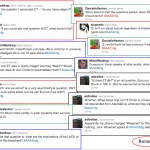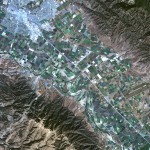NASA’s Kepler team announced last week they’d found more than a thousand potential planets – after just *four months* of observation. The numbers make my head spin like…oh, never mind.
(Since you asked, my favorite Kepler story lede? Dennis Overbye’s, in the New York Times: “Astronomers have cracked the Milky Way like a piñata, and planets are now pouring out so fast that they don’t know what to do with them all.” Scrumptious.)
One of the graphics accompanying the announcement made a rare appearance on the Knight Science Journalism Tracker but wasn’t featured much elsewhere. And since it’s one of my faves, I’m posting the graphic here because it’s worth a rubberneck or two. I promise not to honk.
When I was a kid, I’d blur my eyes and stare at our Christmas tree, and it looked like this:
Now, I can sort of see why media orgs chose other graphics, but this one illustrates the data beautifully: there.are.SO.MANY.potential.planets!
Those little dots represent the locations of Kepler’s candidates, plotted on the telescope’s view field and color-coded by size. Keep in mind that Kepler only scans 1/400th of the sky, and the “transit” detection method can only find a fraction of extrasolar worlds…meaning there are likely many, many more.
Planets are indeed spilling out.
So, as you gaze skyward on a starry night, think for a minute about how many of those twinkling stars might be epicenters for twirling planets – fluffy marshmallow or molten iron worlds, sometimes packed together like gumballs and always dancing rings around their lone stars…








At the risk of sounding simplistic, lights are preeeeetty.
HAHA! I just laughed out loud.
Kepler = awesometude
But if planets are spilling out of the milky way like sweets from a pinata, isn’t the proper response of astronomers obvious? They should be squealing loudly and pouncing.
I bet there was at least a bit of squealing…pouncing I’m not so sure of. Blindfolds? Definitely not.